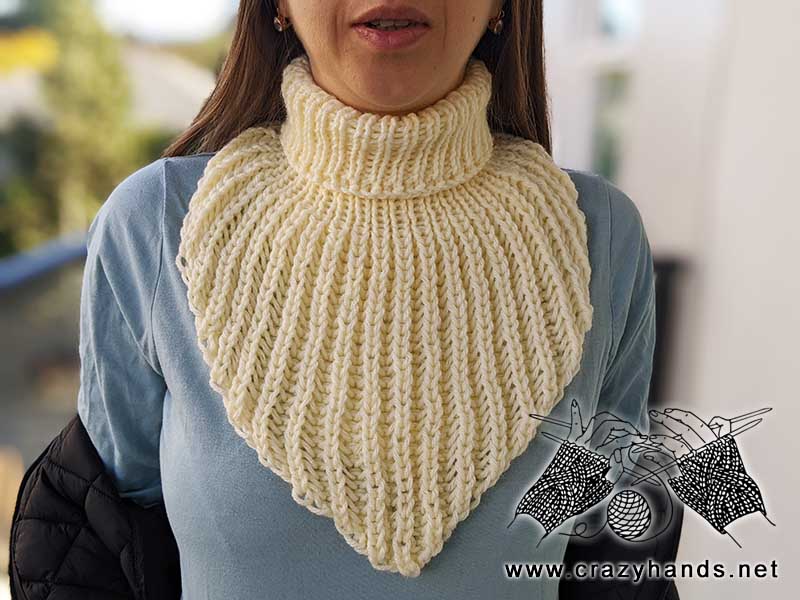Knitted Ribbed Dickey Cowl
Picture a cozy accessory that combines the warmth of a cowl with the stylish texture of ribbed knitting. This versatile piece, known as a knitted ribbed dickey cowl, is the perfect addition to any winter wardrobe. The ribbed design adds a touch of sophistication, while the dickey style ensures a comfortable fit around the neck without the bulk of a full sweater. Whether you're dressing up a casual outfit or adding an extra layer of warmth to a dressier ensemble, the knitted ribbed dickey cowl is a must-have accessory. The soft yarn used in its creation makes it not only fashionable but also incredibly comfortable to wear. With its unique combination of style and functionality, this cowl is sure to become a staple in your cold-weather wardrobe.

Knitting materials and tools:
16” and/or 29” Circular or Straight Knitting Needles 5 mm (US8/UK6)
Super Yarn (4) – 100% Acrylic: 4 ply Knitting Worsted Type. In total: 55 grams.
Crochet hook, scissors, tapestry needle.
Knit ribbed dickey size:
Head circumference: 56-57 cm
Gauge: 16 stitches = 4 inches
Common abbreviations of knitting stitches:
K – knit
P – purl
K1b – knit one below
sel s – selvage stitch: always slip the first stitch knitwise, work to the last stitch, purl the last stitch
Pm – place marker
st(s) – stitch(es)
Ribbed dickey knitting pattern:
Cast on 3 stitches.
Row 1: sel s, k1, sel s.
Row 2: add 1 stitch (When holding the working yarn in the left hand, with the yarn at the back of the work, place the right-hand needle on top of the working yarn, twist needle to form a loop. This loop is counted as one new added stitch), k1, p1, k1. (4 sts) Check the video tutorial if you find the description unclear.
Row 3: add 1 stitch, p1, k1b, p1, k1. (5 sts)
Row 4: add 1 stitch, p1, k1b, p1, k1b, p1. (6 sts)
Row 5: add 1 stitch, k1, p1, k1b, p1, k1b, p1. (7 sts) In the row where, after the newly added stitch, you see a knit stitch, knit it as k1 (knit one) and not as k1b (knit one below). After that, alternate k1b, p1 until the end.
Row 6: add 1 stitch, k1, p1, k1b, p1, k1b, p1, k1. (8 sts) Also, if your last stitch is a knit stitch, knit it as k1 (knit one) and not as k1b (knit one below)
Row 7: add 1 stitch, p1, k1b, p1, k1b, p1, k1b, p1, k1. (9 sts)
Row 8: add 1 stitch, p1, k1b, p1, k1b, p1, k1b, p1, k1b, p1. (10 sts)
Row 9: add 1 stitch, k1, p1, k1b, p1, k1b, p1, k1b, p1, k1b, p1. (11 sts)
Row 10: add 1 stitch, k1, p1, k1b, p1, k1b, p1, k1b, p1, k1b, p1, k1. (12 sts)
Row 11: add 1 stitch, p1, k1b, p1, k1b, p1, k1b, p1, k1b, p1, k1b, p1, k1. (13 sts)
Row 12: add 1 stitch, p1, k1b, p1, k1b, p1, k1b, p1, k1b, p1, k1b, p1, k1b, p1. (14 sts)
Go on knitting by adding one stitch at the beginning of each row until you get 63 stitches or other odd number.
If we measure the triangular part of the dickey now, the width is 22 cm, and the length is 51 cm.
From this point, we start knitting in the round. Optionally, change to shorter circular needles. Slip the first stitch to the right-hand needle, then, with the tip of the left-hand needle, pick up the last stitch and slip it over the first one. Return the first stitch to the left-hand needle. Now, you should have 62 stitches or another even number on your needles.
Round 1: [p1, k1] – repeat around. My round starts with a purl stitch. If your round starts with a knit stitch, knit the first stitch.
Repeat Round 1 until neck part reaches 16 cm. Bind off all stitches using any method you prefer. If you’d like to learn how to create an elastic bind off, check the video tutorial for a demonstration. Weave in ends.